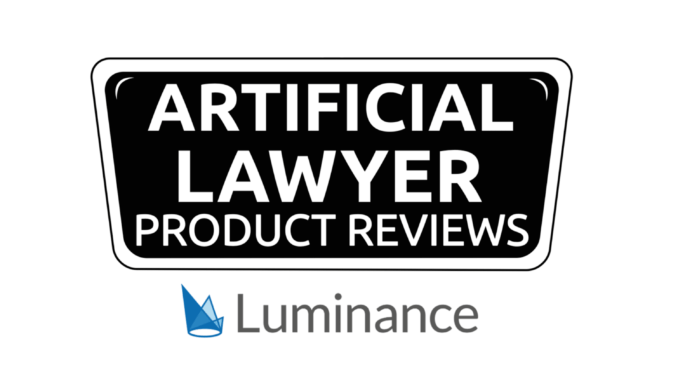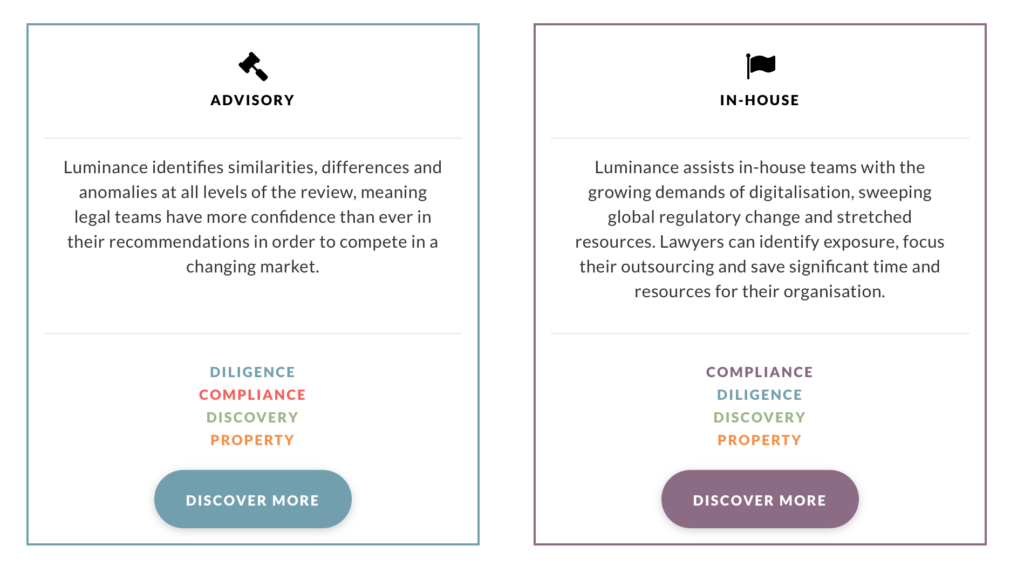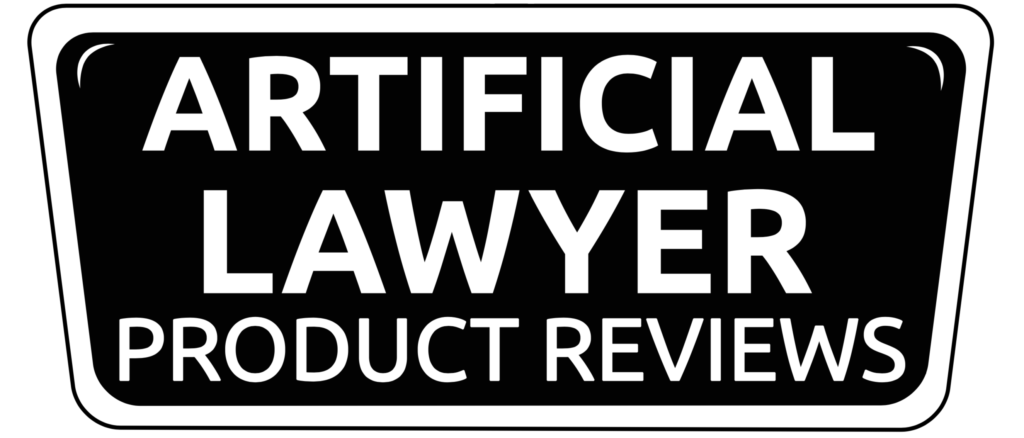
Welcome to the latest Artificial Lawyer Product Review. Today we are presenting Part One of the results for Luminance.
Luminance is a UK-based legal AI doc review and analysis company, and in a short time has become one of the most well-known brands in this category.
It has grown rapidly in terms of its offering (see image below) and in terms of its global client base, with now around 170 customers noted by the company. What started as an M&A due diligence tool, mostly focused on law firms, has broadened to cover a wider range of legal practice needs, such as property and compliance.

In Part One of the review, feedback from the first three questions put to customers (see below) will be covered. In Part Two, to be published later this week, questions on ease of use and customer support, as well as price and value, will be looked at, along with the product’s overall star rating.
Demographic:
AL approached a wide range of publicly known Luminance customers and received back 24 detailed responses. These came from a diverse range of legal businesses, ranging from global in scale to national firms; this includes firms in the US and UK, as well as across Europe and APAC. In addition, we also received some responses where the customer didn’t feel they could comment in detail, but their input was still valuable.
There now follows the review with some commentary for guidance. After this are some concluding thoughts on the findings. Results have been chosen on the basis of representing the most illuminating views of the product. AL has also sought to provide a balance of views, both positive and negative, while giving weight to the most prevalent perspective.
Product Review – Part One
1 – Generally, what have you used the product for?
- Real Estate (leases) and Corporate (commercial contracts Due Diligence).
- We have used Luminance both for M&A due diligence and also for high-volume contract review in Employment and Data Protection.
- We have used Luminance for various tasks, amongst those: M&A Due Diligence, M&A Vendor Due Diligence, Contract Review both for compliance and corporate restructuring purposes.
- Due diligence on commercial transaction and research in litigation matters.
- We are starting to use Luminance to identify LIBOR provisions vulnerable to the transition away from LIBOR and to identify relevant fallback provisions.
- Its use has been limited to making large outsourcing agreements indexed and searchable in advance of, and in real time, during renegotiations of the agreements.
- M&A due diligence; review for GDPR relevant contract clauses; Financing document review; document language identification; large scale document comparison.
- We have used the product for quick analysis of data rooms for preparation of fee proposals for due diligence projects.
- We have tried Luminance only three times since we bought it. We can only use it for documents in the preliminary review category.
Commentary: overall the main use case was for M&A due diligence, as one would expect. However, several customers have been very creative with the use of Luminance and have applied it to multiple areas across their business, as well as for some very specific niche use cases.
This suggests that it is quite adaptable, whether via the use of its pre-trained modules, or where it has been trained by the customers. The use of Luminance’s document discovery capability (i.e. its dashboard that shows what types of documents you have, what language they are in, and other identifying factors) has helped some firms to understand rapidly what work needs to be undertaken.
However, there is also a small group of firms whose feedback was that they have gained limited use from the system, primarily because Luminance is not trained in their main language, (see more below). In such cases the preliminary document discovery capability has been used, but not the main review attributes of the software. Of course, if those firms invested time to train the system in their language they could do more with the software.
2 – How effective is it for your use case, or use cases?
- We have found Luminance to be an effective tool for managing the due diligence process. Our lawyers are impressed by how quickly they can get to the information that matters the most. We have experienced significant time savings when compared with manual review (over 85%) which has enabled us to help clients in time frames that would not have been possible previously and to take on bigger jobs.
- Luminance has been highly effective in speeding up the review of large amounts of documentation, through a combination of using the inbuilt clause/document/data point tagging, as well as our teaching the product to recognise specialist clauses and also different languages. We have found the project management, notes and reporting function to also contribute to the efficiency with which we now carry out large-scale contract review.
- Out of the box boiler plate type clauses perform well. Real Estate out of the box did not perform as well, but we understand more clauses are to be released soon. Lack of integration is a barrier for some of our use cases.
- We have had less success on the M&A due diligence use case, mainly due to the fact that Luminance does not integrate with all data rooms. And even where there is integration, data room permissions are now so strictly controlled that download permissions are not always given.
- Luminance is easy to use as a tool and provides practical solutions for effective due diligence reviews. The visualised view gives an overview of the materials, while it is possible to review documents one by one for a deeper analysis.
- An example of a feature that we consider very useful is the view for side by side comparison of contract clauses. This allows users to analyse and review the most relevant clauses only by clicking them, instead of having to go through all the entire contents of the document.
- Luminance is a great tool for team work and collaboration, as you can distribute the documents by dividing them into tasks and assigning them to users. The system is very interactive and you can easily access the most relevant document by writing any criteria (e.g. which contract clauses, keywords or legislation should be included or not included etc.) in the filter bar.
- Basic functionality works well identifying pre-taught boilerplate clauses (e.g. change of control).
- Luminance allows us to spot potential risk areas very quickly once tailored to the user’s specific needs.
- A little hit and miss. Effective for the right size of job and type of documents.
- It managed to assist the lawyers, but we are yet to know the exact effectiveness.
- Not really useful, since language is an issue and we would have to teach it all four languages [that we mainly use in our legal work].
- When used properly, with proper expectations set, the product has been very effective.
Commentary: it is clear that the majority of firms that provided feedback were very pleased with its effectiveness. As you can see in the text above, some firms explain in detail how Luminance has proven to be effective and delivered value.
It is also clear that there is a spectrum of engagement among the clients. Some firms are deeply engaged with what Luminance can do and are getting a lot out of it. Others seem to be using it quite sparingly. And a small number have not got very far with it because they appear not to want to take on the work of training the software for the main legal languages they use in their jurisdiction.
The final comment about expectations is a good summary of the situation, i.e. where firms have invested time to explore what Luminance can do, as well as trained it where necessary, much has been gained. Where firms have hoped for instant gratification, or expected it to have universal language capabilities without the need for any training, it has delivered less. I.e. While Luminance does come with a notable level of ‘pre-set’ capabilities, including for English and some other languages (see below), effectiveness of the product clearly appears to be related to the engagement level of the customer.
3 – How much use have you got out of the product?
- We are using Luminance for almost all of our active deals.
- The product is used on most transactions with a due diligence element, and other parts of the firm are always looking for ways to make it relevant to their practice areas.
- Difficult to get it to be a business as usual tool. Barriers include finding the right use case (e.g. sufficient volume, sufficient time to test sample project documents, or develop custom clauses, and client consent). [Also] lawyer’s expectations around accuracy and it being a point solution (N.B. it lacks an API to enable integration with other tools).
- We have invested a lot of time on getting to know Luminance and adapting it to [our jurisdiction’s] law terms. We have been engaged on this project for almost 3 years and expect to be able to test Luminance on real projects during next year.
- It has not yet become embedded as a key tool to assist with contract review. This is gradually changing the more we do use it, and share experiences internally.
- We have gotten a lot out of the product. Further, the whole implementation and change management part has been a great learning experience for us, as technology adoption is hard and Luminance has been a great tool to facilitate this process.
- We are working to increase adoption of the technology and we are also trying to find new use cases that may benefit from the technology.
- Not as much as we should have at the moment.
- Usage has been moderate to date, but we are trying to promote greater use throughout the firm.
- Not as much as we’d like. Problem is that DDs are always urgent and at the start of the matter. Until lawyers get over the learning curve, they feel like their old way of doing things is easier.
- Training the system takes time that we don’t have, especially in short engagements [so, use has been limited].
- There has been an education piece around the technology to get our lawyers comfortable with what the technology can do and what the lawyers need to do manually….[and]…usage of the product has steadily grown, with demand to use it and possible use cases growing as our lawyers (and the central knowledge team) become familiar with what its strengths are.
- Luminance have also launched a user portal with short tutorials (most of which are less than a minute long), quick start guides, project guides and suggested workflows, all of which have been of great help in making Luminance accessible for our lawyers.
- Our users like the fact that Luminance doesn’t replace them. They still review what Luminance has done and can easily navigate to every point in the data set where data has come from. This has quickly built up trust in the system.
Commentary: actual use levels seem to vary, at least among the review sample. This is for a variety of reasons, the predominant one appears to be that although the tech has proven to work and the IT/innovation team at that firm have got used to it, the senior lawyers are still accustomed to previous work methods and this has reduced actual use.
However, it was very interesting to see the comment by one firm that as they have made an effort around education on the use of the software, its uptake by partners has increased.
Also, as noted by a customer, Luminance provides tutorials. And, when AL asked the company about how much help it provides customers in terms of getting set up, they responded with: ‘‘Luminance is ‘plug and play’, so the installation process itself is relatively straightforward and usually completed in 30 minutes. However, all of our customers receive a comprehensive onboarding process, which includes a dedicated Account Manager to answer any queries and provide necessary support. The Account Managers are responsible for helping them to get the most out of Luminance, including setting up training sessions, which comprises an overview of the platform, product demo, and a user training on a live project. Account Managers are present for these sessions.’
There will be more on customer support in Part Two.
—
Conclusions on Part One
What does this product feedback tell us? Firstly, it clearly shows that a notable number of firms are using Luminance for client work on a regular basis and that in most cases they are getting value from it.
We can see that some of Luminance’s clients have found ways to make use of the system across a broad range of tasks, not just for M&A work.
There are also some very strong supporters of the software. However, getting adoption to expand across firms is not easy in all cases. I.e. Luminance is ‘through the door’ in a number of legal businesses, yet the frequency of its use is uneven across those firms that provided reviews. But, it also seems that where firms are making a sustained effort to drive internal adoption it is having a positive impact.
The point about not integrating ‘with all data rooms’ is also an apparent barrier to wider use. Although, presumably, this will be overcome in time.
The language issue is a challenge for some firms. One law firm that put out a press release some time ago about how it would be using Luminance was contacted by AL, and we were told the firm could not produce a review because ‘Luminance has not yet developed its software to work well in [our national language]’.
This tells us a couple of things. First, Luminance has been sold to some firms that perhaps didn’t appreciate the training aspect needed in certain scenarios. Second, that Luminance has been sold all over the world, and with such a global reach it must be inevitable that some languages are not built in yet.
AL asked Luminance about the language aspect and this is what they said: ‘Luminance is currently used by lawyers working in 80 languages across 43 countries. Unlike other legal technology vendors on the market, Luminance requires no manual pre-configuration or customised set-up. Using pattern recognition algorithms and unsupervised machine learning, the technology reads and understands documents in any language based on the patterns in that language.
‘Luminance then presents this information back to the lawyer by document type, clause type and jurisdiction, amongst other categories. As lawyers tag and apply meaning to these concepts during a live review, Luminance will learn from the interaction between the user and the technology through its supervised machine learning to become tailored to an individual firm’s specialisms over time. Whilst Luminance does come with a starter pack of pre-built French, Italian, Portuguese, Dutch and Spanish clauses, the technology does not require any pre-built learning in order to provide value to a firm working in any language.
‘Some firms have chosen to carry out pre-training exercises but we have strong evidence that live tagging brings faster results not just because the data set is more realistic, but because even during this process the lawyers work 100% faster than a manual process.‘
—
Part Two will follow later this week, and include sections on ease of use and support, as well as price and value. This second and final part will also include the overall star rating of the product and additional commentary.
Methodology:
Clients of Luminance which had been mentioned publicly were approached by AL for a product review. All responses are anonymous. The questions asked in this review differ from those asked for AL’s first product review, which was of Kira Systems (see review Part 1 and Part 2), in order to have a more versatile range of questions that can apply to more types of software.

5 Trackbacks / Pingbacks
Comments are closed.